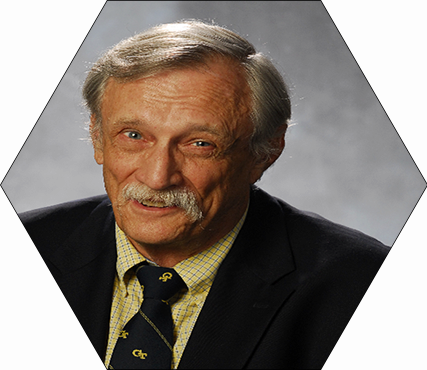Education
- Ph.D., University of California, Berkeley, 1966
- M.Sc., University of Wisconsin, Madison, 1963
- B.Sc., University of Wisconsin, Madison, 1962
Background
Dr. Antolovich's work experience has been varied and is outlined below.
- Lecturer at the University of California, Berkeley, 1966
- Senior Research Metallurgist at Radiation Laboratory, Livermore California, 1966-1968
- Professor of Materials Science at the University of Cincinnati, 1968-1983
- Professor of Materials Science and Engineering at Georgia Tech, 1983-1992
- Director of the Mechanical Properties Research Laboratory at Georgia Tech, 1986-1992
- Director of the School of Mechanical and Materials Engineering at Washington State University, November 1992-August 1999
- Professor of Materials Science and Professor of Mechanical Engineering at Washington State University, 1992-present
- Professor Emeritus in the School of Materials Science and Engineering at Georgia Tech, 2003-present
- Appointments at Ecole des Mines, Conservatoire National des Art et Metiers, Universite de Technologie de Compiegne and Universite de Paris X in France for teaching, research and student advisement, various times from 1976 to present
Research
- Mechanics of Materials: Fatigue, deformation and degradation of materials, high-temperature behavior of materials, application of mechanics and materials to structural failures, and fracture mechanics.
Dr. Antolovich’s major research interests have been in the areas of deformation, fatigue and fracture, especially at high temperatures. His current projects include experimental work and theoretical development of life prediction models for thermomechanical fatigue (TMF).
As depicted in the accompanying figure, Dr. Antolovich’s group is currently studying thermomechanical fatigue (TMF) in which temperatures and strains vary simultaneously and independently. Such conditions occur in jet engines. This work is being carried out to enable engineers to make better predictions of how long components will last. Experiments are carried out in our labs (upper right) to simulate simultaneous changes in temperature and strain (lower left) that are encountered in actual just engine components such as the turbine blade shown in the lower right. These experiments form the basis of models that we are developing to better predict the life.
Dr. Antolovich is the author of more than 100 archival articles in leading technical journals and books, and he has made more than 100 presentations to learned societies in the U.S., Europe, Canada, Korea, and Japan.
Dr. Antolovich’s research has been funded by numerous government agencies, including NASA, Air Force Office of Scientific Research (AFOSR), Wright-Patterson Air Force Base, the Office of Naval Research, NATO, the National Science Foundation, Sandia National Laboratory, and the Canadian Air Force. Companies funding his research include: Alcoa, GE, Haynes International, Georgia Iron Works, Southwire, Garrett, Cummins Engine, Pratt and Whitney, Northrop, and McDonnell-Douglas.
Dr. Antolovich has also been a consultant to major industrial organizations such as Alcoa, GE, Allied Signal, Cummins Engine, Pratt and Whitney, Northrop, Satec Systems, Chromalloy, Oshkosh Trailers, and Balfour Beatty.
|
Thermomechanical Fatigue (TMF: Continuously cycling Out-of-Phase (OP): max temp at min load In-Phase (IP): max temp at max load
|
| OP cycle (graph), in-progress TMF experiment (upper right), turbine blade (lower right). |
Distinctions & Awards
American Society of Mechanical Engineers
- Fellow, 2000
- Nadai Medal for contributions to understanding deformation, fatigue and fracture of engineering and model materials, 1990
ASM International
- Zay Jeffries Lecture at ASM Cleveland, 2009
- Fellow, 1987
Georgia Institute of Technology
- Outstanding Research Development Award, 1987
- Graduate Student Senate Outstanding Faculty Member, 1984
Washington State University
- Lindholm Professor of Materials Science, 1999-2002
- Oustanding MSE Instructor, 2001
French Metallurgical Society
- Reaumur Medal in recognition of accomplishments in fracture and fatigue, 1987
University of Cincinnati
- Outstanding Teacher in the Engineering College, 1972
Representative Publications
A. Pineau and S. D. Antolovich. 2009. High Temperature Fatigue of Nickel-Base Superalloys - A Review With A Special Emphasis on Deformation Modes and Oxidation. Engineering Failure Analysis 16, 2668-2697
A. Pineau and S. D. Antolovich. 2009. Fatigue a Haute Temperature, InLa Fatigue des Materiaux et des Structures. C. Bathias and A Pineau, Editors. Lavoisier, France,3, 19-155.
S. D. Antolovich and K. Findley, 2009. A New Look at Attractive/Repulsive Junctions and Cleavage Crack Formation in BCC Materials. Engineering Fracture Mechanics 77, 201-216.
E. Bayraktar, S. D. Antolovich and C. Bathias, 2006. Multiscale Study of Fatigue Behaviour of Composite Materials by X-rays Computed Tomography,International Journal of Fatigue 28, 1322-1333.
S. D. Antolovich and A. Saxena, 2002.Thermomechanical Fatigue: Mechanisms and Practical Life Analysis. ( W. T. Becker and R. J. Shipley, Editors)ASM Handbook 11, Faiture Analysis and Prevention, ASME International, Materials Park, Ohio, 738-745.



